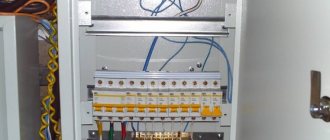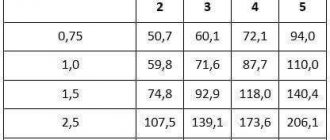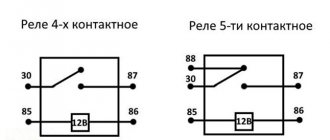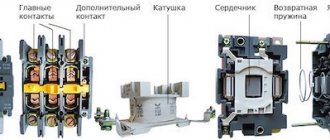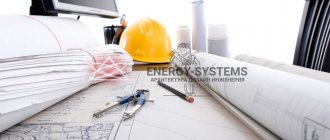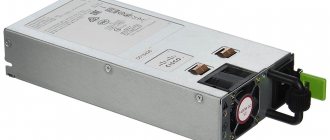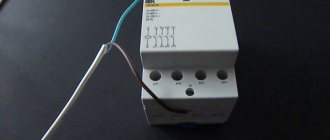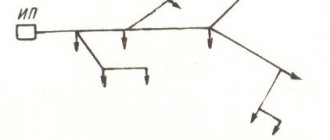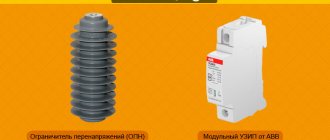Why is RB needed?
The main purpose of the distribution block is to distribute electrical cables across sections. That is, it turns out that one input cable enters the device, and several wires of a smaller cross-section come out of it. By the way, the cross-section may be the same for each output cable, or maybe different. Everything will depend on the current load operating or planned at each site. In short, there is one input, several outputs to consumers.
Manufacturers today offer several design models that are installed on different network circuits.
- To the zero bus.
- To phase.
- Combined option.
Example of connections using a cross-module
The simplest design is zero. This is a device in a plastic case, inside there is a copper bus separated by plastic partitions. The wires are fastened to the bus using screws. The latter can be for a screwdriver or a wrench.
The phase design exactly repeats the zero one. But when manufacturing devices of this type, manufacturers take into account that they will operate at a voltage of 1000 volts under a current load of 500 amperes. It should be noted that this type of device is made of special plastic. It is heat-resistant and self-extinguishing. As they say, safety comes first.
A combined crossover module is two identical parts in one housing. That is, both the network phase and the zero can be passed through it simultaneously. For distribution boards in which a large branching is installed across sections and there are a large number of electrical appliances, this is the optimal solution. A diagram of such a connection will be discussed below.
What is interesting in terms of the module design. Its top cover is transparent. This is, firstly, beautiful, and secondly, you can visually see all, so to speak, the ins and outs of the device. Some manufacturers make holes in the covers for clamping screws. This is convenient because when tightening the contacts there is no need to remove the cover itself. There are no restrictions on wires (copper or aluminum).
Design
Rationale for use
There is an opinion according to which, when assembling an electrical panel, it is better not to use cable cross-connection modules, since they reduce the useful space in the distribution panel, that is, they clutter it. In addition, the cost of equipment increases.
There is some justice in this statement, especially considering that the overall price of the system will increase, albeit slightly. On the other hand, the use of cross modules provides undoubted advantages; let’s consider them:
- accuracy of installation, to make it clearer, below is a photo showing distribution boards with and without cross-modules. There is no need to designate each of them; the difference is clearly visible.
From the photograph it immediately becomes clear where it will be easier to understand the distribution board diagram or, if necessary, reconnect the lines. So in this case, the aesthetics are quite justified;
- low probability of short circuit; in multi-pole blocks, contact groups are separated by partitions. Please note that despite this, all electrical installation work must be carried out only with the equipment de-energized;
- fastening the wire to the bus ensures reliable contact, which eliminates heating at the connection point;
- a variety of models that allow you to implement connection diagrams of any complexity.
Connection
Installing and connecting the cross-module is not difficult. The case is simply mounted on a DIN rail, so it can be installed very quickly. Switching wires is also easy. The video below shows how to connect a crossover module, and also clearly demonstrates the advantage of using it:
Connection diagram
Advantage of installation
So we looked at what a cross-module is, why it is needed and what sizes this product comes in. Finally, we recommend buying a modular distribution block from trusted manufacturers: ABB, IEK, Legrand, Dekraft or Schneider Electric. The quality of materials plays a very important role in the operation of this device.
We also recommend reading:
- How to assemble a distribution board
- What types of DIN rails are there?
- Connection diagrams for a three-phase electricity meter
Selection rules
In order for the device to operate properly, for a long time and reliably, a competent choice is required.
When purchasing, you should pay attention to the following points: . Maximum current load of distribution block
It should be noted that the use of smaller established values is not permitted. This is a determining factor at the time of purchase related to the safety of the device. The good thing is that there is protection on the linear side of the cross. Manufacturer. Well-known players in the market for such services are Schneider Electric, IEK, ABB, and other manufacturers. There is an opinion that foreign models are of higher quality and better than domestic options. This is debatable. Now a number of domestic companies have started producing equally high-quality products. Availability of a certificate for the product. When purchasing, you must ask for a certificate for the product, since such products are subject to mandatory certification. Attention is drawn to the dimensions of the device in accordance with the dimensions of the electrical panel in which it will be located. Naturally, the product should not have external defects. The price of the device has a certain influence on the choice. There are a large number of options and everyone chooses a model in accordance with their financial capabilities.
- Maximum current load of the distribution block. It should be noted that the use of smaller established values is not permitted. This is a determining factor at the time of purchase related to the safety of the device.
- The good thing is that there is protection on the linear side of the cross.
- Manufacturer. Well-known players in the market for such services are Schneider Electric, IEK, ABB, and other manufacturers. There is an opinion that foreign models are of higher quality and better than domestic options. This is debatable. Now a number of domestic companies have started producing equally high-quality products.
- Availability of a certificate for the product. When purchasing, you must ask for a certificate for the product, since such products are subject to mandatory certification.
- Attention is drawn to the dimensions of the device in accordance with the dimensions of the electrical panel in which it will be located.
- Naturally, the product should not have external defects.
- The price of the device has a certain influence on the choice. There are a large number of options and everyone chooses a model in accordance with their financial capabilities.
Modular distribution block: its functions and advantages
The main purpose of the modular block is to branch conductors to the required areas. It clearly looks like this: one electrical wire goes into the device, and several come out, only with a different cross-section.
A cross-module or RB is needed to simply and most conveniently distribute power in the panel. Most often this is needed in those shields where there are three phases. This is due to the need to avoid connecting loops, and the ability to regulate the load level on the phases.
Advantages of distribution blocks:
- Aesthetics – the module located on the DIN rail looks very neat and allows you to quickly find out where everything is;
- Safety of use – it is better for a person without experience to use abb cross-modules, which reduce the risk of a short circuit in the electrical circuit;
- Reliable and durable contact of conductors due to its special design;
- Large selection of permissible wire sections;
- Possibility to use the cable both with and without a tip;
- IP 20 class protection of the front part of the panel, which protects a person from accidental contact with the current parts of the device.
Types of cross modules
The distribution modules (blocks) are separated according to the cross-section of the wire, which is inserted into the terminal at the input. Of course, current load is also taken into account. Let's identify all the available positions, especially since there are not very many of them.
- RB-80 1P 80A. It is clear that such a device can withstand a current of 80 amperes. But we are interested in wire cross-sections. So, you can insert a wire with a cross-section of 16 mm² into this block, and output 4x6 or 2x16.
- RB-125. Input wire – 16 or 35 mm², output wire: 6x16.
- RB-160. Introductory: 16; 35 or 70 mm², output: 6x16.
- RB-250. Input: 120 mm², output: 4x10; 5x16 and 2x35.
- RB-400. Input: 185 mm², output: 4x10; 5x16 and 2x35.
- RB-500. This model has flat contacts. Input width: 15-24 mm, thickness 3-8. But the output terminals repeat the two previous positions.
Of course, such a wide range of models is required mainly for production facilities. In household electrical networks, the first position will be sufficient. Rarely is the second position used.
Cross module connection diagram
Why does the cross module make it easier to install a distribution board? Imagine a scheme in which a voltage relay is installed on every section of the building's electrical wiring. Let it be a single-phase supply network. How does it connect?
A wire is output from the meter, which is twisted and divided into several sections. A twist connects one large cross-section cable and several small ones. Not a very convenient contact. By installing a distribution block between the meter and the relay, you can make the circuit more convenient. This device will take up little space, but both the phase circuit and the neutral circuit will pass through it at once. In this case, there are no twists, no connection of large-section wires with small ones, and there is no installation through terminal distributors, where two or three wires are inserted into one terminal at the same time. In this case, like all devices, the cross module is installed on a DIN rail.
And one last thing. With such a device you can easily carry out diagnostics. It does this, you just need to disconnect the required (diagnosed) section from the electrical network in the cross module. If for some reason it is necessary to change the circuit for distributing electricity along the loops, then all this can be done in the distribution block by swapping the wires. The most important thing is that the wiring diagram itself does not change. That is, there is no need to change the location of devices and DIN rails, wires and connection points.
Fastening
The cross-modules can be secured with self-tapping screws or by installing them on a DIN rail. The last option is the most convenient, so during installation it is preferred.
This type of fastening device allows you to install different types of electrical devices, if you take into account their sizes and the most optimal option for laying wires.
Various types of devices can be installed on the Din rail
The use of DIN rails allows you to compactly install all devices and, if necessary, organize their multi-level placement, which allows you to rationally use the space in the distribution board.
Example of use.
Let's give an example of how an electrical panel diagram can be simplified through the use of cross-modules. Let's say we need to organize a multi-level electrical network throughout the building from a three-phase input line. This means that we should wire from the input machine to the RCD to connect each line.
If there are two or three of them, the connection can be made directly to the terminals of the machine. But when there are more of them, all the wires may simply not fit in the connector, and the current load does not allow them to be taken with a smaller cross-section. The problem can be solved by twisting (which is not reliable), using a bolted connection (inconvenient) or installing a cross-connect module (four-pole).
This solution will be the most optimal - the device does not take up much space and allows you to switch both neutral and phase wires. There is no need to install terminal distributors where several wires are connected to one contact, which creates problems when it is necessary to test power lines or reconnect them.
The cross-module allows you to perform switching without changing the wiring diagram, as well as the position of Din rails and electrical appliances, which is quite convenient.
Why do you need a cross module?
Standard situation: the input cable goes immediately to the input machine, after which it disperses into packets going directly to consumers. On the one hand, there are no violations in such a scheme, but further installation of electrical wiring may be slightly difficult.
Figure 3: Any cross-module consists of copper busbars
When installing a cross-module, the wires from the input machine first go to it, and then to the machines to consumers. This scheme is simple and convenient, since, firstly, the number of wires is minimized, and secondly, it becomes possible to quickly connect (disconnect) new lines.
Advice! When installing a new cross-module on a three-phase system, you must choose a product with a supply of holes, for example, a model with four busbars of 15 holes each. A small reserve will save nerve cells in the future, when you want to install a hob, install a boiler or connect a low-current line.
The four buses of the cross-module should be distributed between three phases and a working zero. It is best to attach the grounding separately, with appropriate markings. The entire installation of conductors to the cross-module is carried out simply and quickly: unscrew the fixing screw on the bus with a screwdriver, insert the stripped end of the wire into the hole and tighten and tighten the screw securely.
The cross-module is a convenient and safe product that will save a lot of time and effort in the future. It has an affordable price and a long service life - irreplaceable qualities for electrical products.
Advantages of distribution blocks
Some electricians have a negative attitude towards cross modules, believing that they clutter the distribution board, plus the extra costs of purchasing an additional element. Don't tell me, this block has several positive qualities.
- No one has yet canceled the aesthetic side of the matter. A cross module installed on a DIN rail in a shield is not only about the functionality of the device and the quality of the connection, it is about beauty. This was especially appreciated by electricians who offer their services for installing electrical wiring in private houses. The owners of such houses are willing to pay for beauty. And there is nothing reprehensible in this. In addition, everything inside the shield falls into place, it becomes neat.
- A monolithic contact bar is located inside the distribution block. It is usually made from tinned copper or brass. And if the shield itself is assembled by a beginner, then the possibility of shortening the zero phase through the block simply will not work. Of course, short circuit is an extreme situation, but for those whose hands grow from the wrong place, it is recommended to use cross modules.
- Reliable fixation of the wire inside the contact with a screw with a hex key, plus the thread of the screw is longer than conventional clamps - this is a high quality contact that real professionals could appreciate.
- And as mentioned above, this is a fairly wide range of wire sections that can be clamped in cross modules.
Design features
The design of the modules depends on their purpose. During electrical installation work, the following RBs are used for cross-connection:
- for the zero bus (PEN);
- phase (L);
- combined (L PEN).
The design of the first is the simplest: a copper bus is placed in a plastic case, the fastening points are separated by partitions (made of the same material as the body), the wires are attached to the bus using screws.
Dimensions of Leg cross modules (LeGrand) for the zero bus: “A” - 2x7 and “B” - 4x7 connections
The design of phase modules is practically no different from those intended for the zero bus, with the exception of the materials used, since they must withstand a certain current load. For the same reason, the body of such structures is made of heat-resistant, self-extinguishing plastic.
Image of IEK cross-module (L-PEN stepped housing)
As for combined designs, they represent the two previous types combined in a single body. That is, with their help you can simultaneously switch both zero and phase (phases). Note that the use of such modules in electrical distribution boards with a large number of branches will be the most optimal solution.
Photo of a combined four-pole cross-module
Almost all manufacturers provide the contactor with a hinged cover to protect the contacts from foreign objects. Some make it transparent, so you can assess the condition of the contact groups without removing the cover.
It should be noted that cross-panels are used not only for branching electrical circuits. There are devices for cross-posting (switching) of a digital network using twisted pair or fiber optics.
Optical crossover module for 32 SC ports (LC duplex)
Such devices are installed in special structures - cross-connections, where there is a flat profile (strafe) for attaching plinths (modules) for a certain number of pairs.
Telephone multi-module wall-type cross-connect Wall-mounted dust-moisture-proof cross-connect (KPV) for fiber optics with several APC-320SC/APC SSD VOKS-B modules
Dimensions of Leg cross modules (LeGrand) for the zero bus: “A” – 2×7 and “B” – 4×7 connections
Almost all manufacturers provide the contactor with a hinged cover to protect the contacts from foreign objects. Some make it transparent, so you can assess the condition of the contact groups without removing the cover.
Telephone multi-module cross-wall type
Wall-mounted dust- and moisture-proof cross-connect (CPW) for fiber optics with several APC-320SC/APC SSD VOKS-B modules
Telephone multi-module cross-wall type
Depending on the number of metal busbars, distribution blocks can be used in single-phase or three-phase networks. They differ in the number of connections and load value. In addition, three types of models are available for switching wires for various purposes:
- Null. The plastic case contains one tire with clamps. Connecting wires using screw terminals.
- Phase. Outwardly similar to zero, only the bus is designed for a high load at a voltage of 1000 volts and a current of 500 amperes. The body of such a device is made of heat-resistant plastic.
- Combined type, which contains busbars for connecting phases and neutral wires. For industrial networks with a large number of branches, such a cross-module is the most suitable option.
The industry produces models of distribution blocks for information networks. Used to connect optical fiber and twisted pair cables.
Safe cross-module on DIN rail
The use of various twists and screws when distributing wires on the panel is gradually becoming a thing of the past due to its unsafety and inconvenience of work.
Today, a cross-module can be installed in two main ways:
- On DIN rail;
- Using self-tapping screws on the boards.
If it is not possible to install the RB on the mounting rail, you can fasten it with self-tapping screws.
The distribution block is installed between the voltage relay and the meter. If you need to change the distribution of energy among the branches, this can be easily done by changing the arrangement of the cables in the device. The wiring diagram will remain unchanged.
